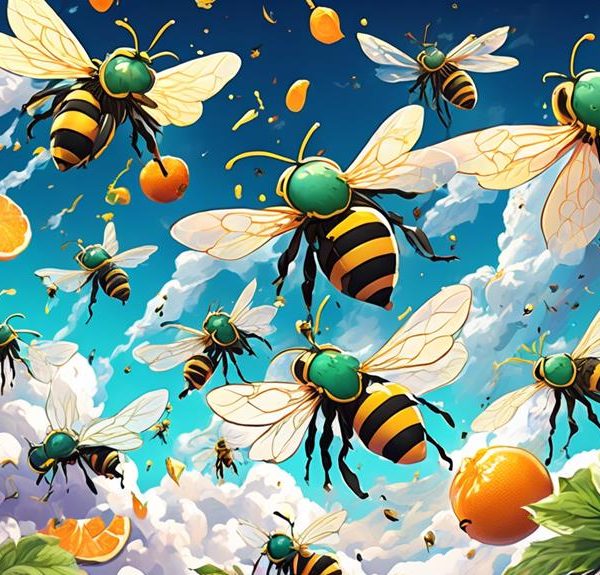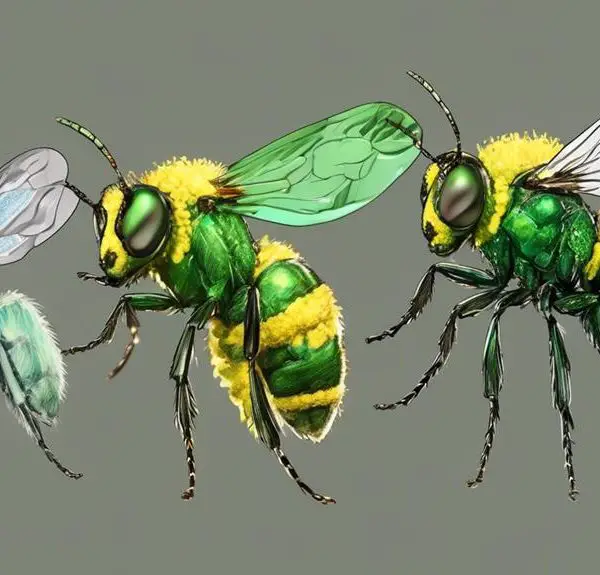Yearning to understand the surprisingly potent sting of the giant sweat bee? Dive into our guide to discover its secrets and how to soothe the after-effects.

Giant Sweat Bee Sting
Ever wondered how something as minuscule as the giant sweat bee can pack such a punch with its sting? You're not alone in this quest for knowledge. The sting of a giant sweat bee, despite its seemingly harmless size, can be quite a nuisance and cause discomfort.
It's not just the physical sting that's bothersome, but the lingering effects that might follow. In the next few sections, we'll pull back the curtain on this tiny terror, exploring the nature of its sting, the symptoms you might experience, and what you can do if you find yourself on the receiving end.
Buckle up; it's about to get interesting.
Key Takeaways
- The Giant Sweat Bee belongs to the Halictidae family and has a metallic green or blue body.
- It is a solitary bee that builds its own nest and is attracted to sweat as a source of salt.
- The bee is not aggressive unless provoked and is found in gardens, parks, and forests.
- When stung by a Giant Sweat Bee, immediate reactions include sharp, burning pain, redness, swelling, itching, and inflammation.
Understanding the Giant Sweat Bee
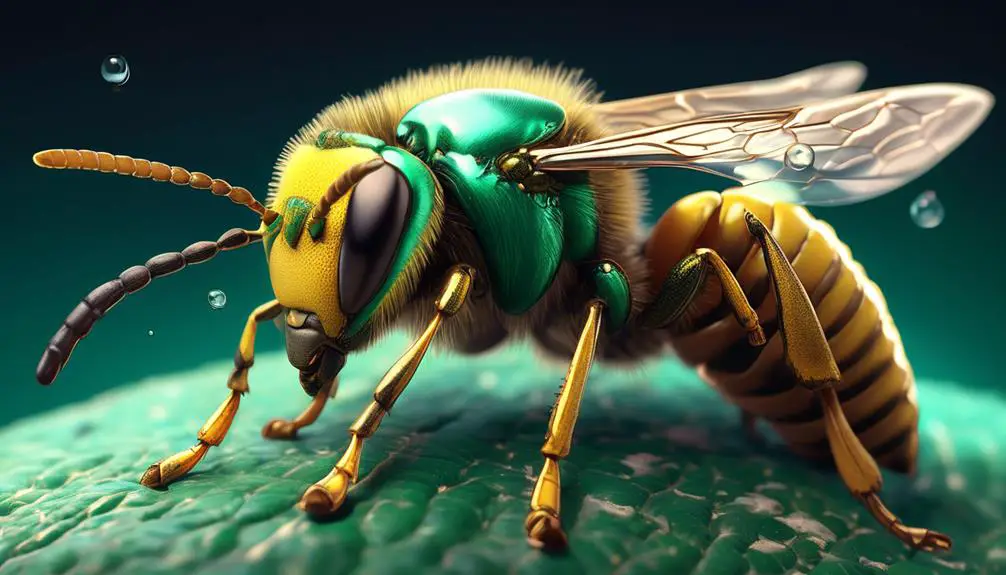
To fully comprehend the giant sweat bee, you need to delve into its unique characteristics, behavior, and interaction with its environment. This bee, belonging to the Halictidae family, is quite a spectacle with its metallic green or blue body. It's a solitary bee, meaning it doesn't live in large colonies like honeybees or bumblebees. Instead, the female builds and provisions her own nest without the help of worker bees.
What's interesting is their behavior towards sweat. They're attracted to it because it's a source of salt for them, hence the name. However, don't mistake their interest as hostility. They're not aggressive unless provoked and their sting is relatively mild compared to other bees.
In terms of environmental interaction, you'll find them in gardens, parks, and forests, pollinating a variety of plants. However, their solitary nature means they don't contribute to pollination as much as social bees. They're also quite adaptable to varying temperatures and can survive in diverse climates.
The Sting: What Happens?

Should you unfortunately encounter a sting from a giant sweat bee, your skin's immediate reaction might include a sharp, burning pain followed by redness and swelling, symptoms typical of most bee stings. The venom injected into your skin contains a variety of compounds, including peptides and enzymes, which cause these symptoms.
Reaction | Description |
|---|---|
Pain | Often described as sharp and burning |
Redness | Your skin may appear flushed around the sting |
Swelling | This can vary in size and typically surrounds the sting |
Itching | You may experience itchiness at the sting site |
Inflammation | This is your body's response to the bee venom |
As your body's immune system responds, it releases histamine which can cause an itching sensation. Inflammation is another common reaction, as your body attempts to isolate the venom and prevent it from spreading. It's crucial to monitor these symptoms closely. If they persist or worsen, it could indicate an allergic reaction which requires immediate medical attention. In general, a giant sweat bee sting is unpleasant but usually not dangerous.
Symptoms of a Sweat Bee Sting
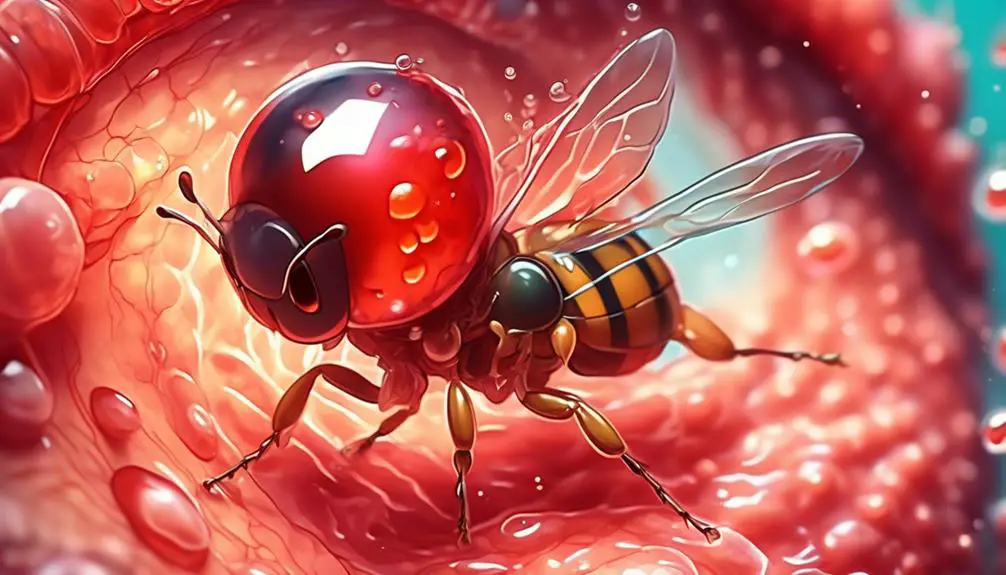
Building upon the initial reactions to a giant sweat bee sting, it's crucial to understand the specific symptoms that may follow this unpleasant experience. Immediately after you've been stung, you'll likely experience a sharp, burning pain at the sting site. This is soon followed by redness, swelling, and warmth around the area, all signs of your body's inflammatory response.
In a more detailed scientific analysis, these symptoms result from the venom the sweat bee injects, which contains enzymes and peptides that trigger pain receptors and promote inflammation. The redness and swelling are due to increased blood flow and the accumulation of immune cells at the site, a sign of your body's attempt to neutralise the venom and repair the tissue damage.
In some cases, you might also notice a white spot at the sting site, which is actually the stinger left behind. It's important to remove it carefully to avoid pushing more venom into your skin. While these symptoms will typically subside within a few hours to a day, if you're allergic to sweat bee venom, you might experience severe reactions, including difficulty breathing, hives, and even anaphylaxis.
Treatment Options Post-Sting
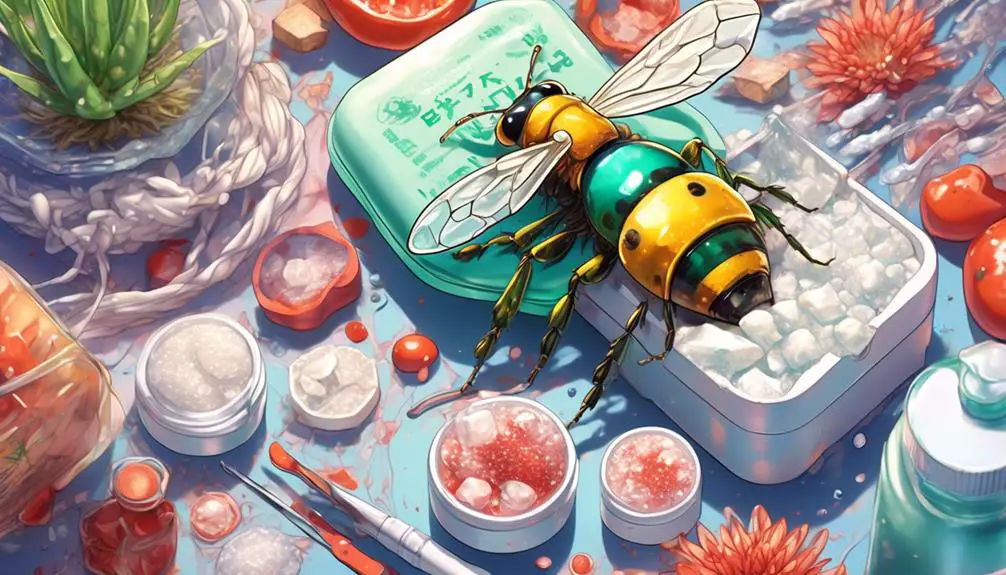
After a giant sweat bee's sting has left its mark, your immediate response can significantly influence the severity of the symptoms and the speed of recovery. The first step is to remove the stinger if it's still embedded in your skin. Use a flat object, such as a credit card, to scrape it out sideways. Avoid using tweezers or pinching the stinger directly, as this could squeeze more venom into the wound.
Next, thoroughly wash the area with soap and water to prevent infection. Apply a cold pack to reduce swelling and ease pain. Over-the-counter pain relievers and antihistamines can be used to alleviate discomfort and itching.
Monitor the sting site for signs of infection, such as persistent redness, swelling, or pus. If these symptoms appear, seek medical attention promptly.
In rare cases, a sweat bee sting can cause an allergic reaction with symptoms like difficulty breathing, hives, or rapid heartbeat. If you experience these, it's crucial to get emergency medical help immediately.
Preventing Sweat Bee Encounters

While treating a sweat bee sting is crucial, it's equally important to understand how to prevent these encounters in the first place. Sweat bees are attracted to perspiration, hence the name, and are most active during warm, humid months. Therefore, it's advisable to minimize sweating by limiting outdoor activities during peak hours, particularly in hot weather.
Wearing light-colored clothing can also reduce your chances of attracting these bees. Studies indicate that sweat bees, like many other insects, are drawn to dark colors. Therefore, lighter clothes aren't as appealing to them.
Furthermore, certain scents, particularly floral and sweet ones, are irresistible to these bees. So, it would be wise to avoid wearing perfumes or scented body lotions when going outdoors during sweat bee season.
Lastly, maintaining a clean environment is crucial since sweat bees are drawn to places with ample food sources. Regularly removing trash, especially food waste, will deter sweat bees from setting up colonies near your home.
In essence, prevention is the best way to protect against sweat bee stings. By understanding their behavior and taking appropriate measures, you can effectively reduce your chances of an encounter with these insects.
Conclusion
So, you've learned a lot about the giant sweat bee, haven't you? You know how their sting works, the symptoms to watch out for, treatments to ease the discomfort, and even how to prevent encounters.
Remember, knowledge is power. Stay alert and informed, and you'll be well equipped to handle a potential sweat bee sting.
As always, if symptoms persist or worsen, seek medical attention immediately.

